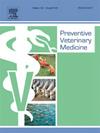脓性阴道分泌物、酯酶、光度测定和三种细菌学检测在奶牛子宫感染诊断中的贝叶斯潜在类分析的有效性
IF 2.4
2区 农林科学
Q1 VETERINARY SCIENCES
引用次数: 0
摘要
本前瞻性横断研究旨在评估实验室细菌培养、石化膜、三板、光度法、阴道脓性分泌物(PVD)和酯酶正确识别奶牛子宫感染的能力,并评估这些测试在不同情况下的实用性。我们对7个农场29至43天的奶牛进行了取样。我们认为所有六种检测方法都不能很好地识别子宫感染,并使用贝叶斯潜类分析来估计它们的敏感性和特异性。我们创建了10个场景,包括单独测试、串联测试或并行测试,并计算了预测值和错误分类成本项(mct)。所有估计都以95% %贝叶斯可信区间(BCI)表示。共采集子宫标本326份。实验室培养的效度最佳(灵敏度= 0.87,95 % BCI = 0.77-0.97;特异性= 0.71,95 % BCI = 0.58-0.86)。其他检测具有相似的特异性,但灵敏度较低,PVD的灵敏度最低(0.05,95 % BCI = 0.01-0.10)。如果认为治疗一头健康的奶牛比不治疗一头子宫感染的奶牛更糟糕,那么光测法得出的MCT与实验室培养相似。这些发现突出表明,目前用于鉴定可能受益于宫内抗菌治疗的奶牛的农场工具不能准确识别子宫感染。虽然实验室培养是最准确的测试,但它不容易在农场实施。光度法的有效性很好,但需要进一步的研究来了解如何实施它来提高宫内抗菌药物的明智使用。本文章由计算机程序翻译,如有差异,请以英文原文为准。
Validity of purulent vaginal discharge, esterase, luminometry, and three bacteriological tests for diagnosing uterine infection in dairy cows using Bayesian latent class analysis
This prospective cross-sectional study aimed to evaluate the ability of laboratory bacterial culture, Petrifilm, Tri-Plate, luminometry, purulent vaginal discharge (PVD), and esterase to correctly identify uterine infection in dairy cows, and to assess these tests’ usefulness in different situations. We sampled dairy cows between 29 and 43 days in milk in seven farms. We considered all six tests imperfect to identify uterine infection and used Bayesian latent class analyses to estimate their sensitivity and specificity. We created ten scenarios, including tests alone, in series, or in parallel, and we calculated predictive values and misclassification cost terms (MCTs). All estimates are presented with 95 % Bayesian credibility intervals (BCI). A total of 326 uterine samples were collected. The laboratory culture had the best validity (sensitivity = 0.87, 95 % BCI = 0.77–0.97; specificity = 0.71, 95 % BCI = 0.58–0.86). The other tests had similar specificity but lower sensitivity, with PVD having the lowest sensitivity (0.05, 95 % BCI = 0.01–0.10). If treating a healthy cow was considered worse than leaving a cow with a uterine infection untreated, luminometry yielded an MCT similar to the laboratory culture. These findings highlight that the on-farm tools currently used to identify cows that could benefit from intrauterine antimicrobial treatment do not identify uterine infection accurately. While the laboratory culture was the most accurate test, it cannot easily be implemented on farms. Luminometry’s validity was good, but additional research is necessary to understand how it can be implemented to improve judicious intrauterine antimicrobial use.
求助全文
通过发布文献求助,成功后即可免费获取论文全文。
去求助
来源期刊

Preventive veterinary medicine
农林科学-兽医学
CiteScore
5.60
自引率
7.70%
发文量
184
审稿时长
3 months
期刊介绍:
Preventive Veterinary Medicine is one of the leading international resources for scientific reports on animal health programs and preventive veterinary medicine. The journal follows the guidelines for standardizing and strengthening the reporting of biomedical research which are available from the CONSORT, MOOSE, PRISMA, REFLECT, STARD, and STROBE statements. The journal focuses on:
Epidemiology of health events relevant to domestic and wild animals;
Economic impacts of epidemic and endemic animal and zoonotic diseases;
Latest methods and approaches in veterinary epidemiology;
Disease and infection control or eradication measures;
The "One Health" concept and the relationships between veterinary medicine, human health, animal-production systems, and the environment;
Development of new techniques in surveillance systems and diagnosis;
Evaluation and control of diseases in animal populations.
 求助内容:
求助内容: 应助结果提醒方式:
应助结果提醒方式:


